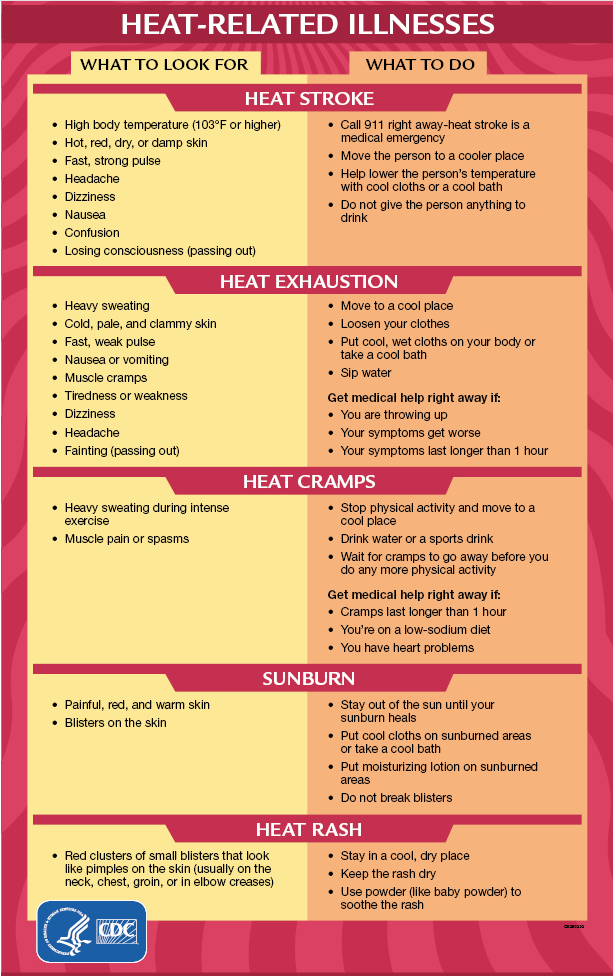Cold Related Illness
The temperature forecast is below the threshhold where cold stress could become a safety concern.
Use the chart and table below for recommendations on risk, work/rest scheduling, hydration and mitigation.
Hypothermia
When exposed to cold temperatures, your body begins to lose heat faster than it can be produced. Prolonged exposure
to cold will eventually use up your body’s stored energy. The result is hypothermia, or abnormally low body temperature.
A body temperature that is too low affects the brain, making the victim unable to think clearly or move well. This makes
hypothermia particularly dangerous because a person may not know it is happening and will not be able to do anything about
it.
Symptoms
Symptoms of hypothermia can vary depending on how long you have been exposed to the cold temperatures.
Early Symptoms
- Shivering
- Fatigue
- Loss of coordination
- Confusion and disorientation
Late Symptoms
- No shivering
- Blue skin
- Dialated pupils
- Slowed pulse and breathing
- Loss of consciousness
First Aid
Take the following steps to treat a worker with hypothermia:
- Alert your supervisor and request medical assistance.
- Move the victim into a warm room or shelter.
- Remove their wet clothing.
- Warm the center of their body first-chest, neck, head, and groin-using an electric blanket, if available; or use
skin-to-skin contact under loose, dry layers of blankets, clothing, towels, or sheets.
- Warm beverages may help increase the body temperature, but do not give alcoholic beverages. Do not try to give
beverages to an unconscious person.
- After their body temperature has increased, keep the victim dry and wrapped in a warm blanket, including the head
and neck.
- If victim has no pulse, begin cardiopulmonary resuscitation (CPR).
Frostbite
Frostbite is an injury to the body that is caused by freezing. Frostbite causes a loss of feeling and color in the
affected areas. It most often affects the nose, ears, cheeks, chin, fingers, or toes. Frostbite can permanently damage
body tissues, and severe cases can lead to amputation. In extremely cold temperatures, the risk of frostbite is increased
in workers with reduced blood circulation and among workers who are not dressed properly.
Symptoms
Symptoms of frostbite include:
- Reduced blood flow to hands and feet (fingers or toes can freeze)
- Numbness
- Tingling or stinging
- Aching
- Bluish or pail, waxy skin
First Aid
Workers suffering from frostbite should:
- Get into a warm room as soon as possible.
- Unless absolutely necessary, do not walk on frostbitten feet or toes-this increases the damage.
- Immerse the affected area in warm-not hot-water (the temperature should be comfortable to the touch for unaffected
parts of the body).
- Warm the affected area using body heat; for example, the heat of an armpit can be used to warm frostbitten fingers.
- Do not rub or massage the frostbitten area; doing so may cause more damage.
- Do not use a heating pad, heat lamp, or the heat of a stove, fireplace, or radiator for warming. Affected areas are numb and
can be easily burned.
Trench Foot
Trench foot, also known as immersion foot, is an injury of the feet resulting from prolonged exposure to wet and cold conditions.
Trench foot can occur at temperatures as high as 60 degrees F if the feet are constantly wet. Injury occurs because wet feet lose
heat 25-times faster than dry feet. Therefore, to prevent heat loss, the body constricts blood vessels to shut down circulation
in the feet. Skin tissue begins to die because of lack of oxygen and nutrients and due to the buildup of toxic products.
Symptoms
Symptoms of trench foot include:
- Reddening of the skin
- Numbness
- Leg cramps
- Swelling
- Tingling pain
- Blisters or ulcers
- Bleeding under the skin
- Gangrene (the foot may turn dark purple, blue, or gray)
First Aid
Workers suffering from trench foot should:
- Remove shoes/boots and wet socks.
- Dry their feet.
- Avoid walking on feet, as this may cause tissue damage.
Chilblains
Chilblains are caused by the repeated exposure of skin to temperatures just above freezing to as
high as 60 degrees F. The cold exposure causes damage to the capillary beds (groups of small blood vessels)
in the skin. This damage is permanent and the redness and itching will return with additional exposure. The
redness and itching typically occurs on cheeks, ears, fingers, and toes.
Symptoms
Symptoms of chilblains include:
- Redness
- Itching
- Possible blistering
- Inflammation
- Possible ulceration in severe cases
First Aid
Workers suffering from chilblains should:
- Avoid scratching
- Slowly warm the skin
- Use corticosteroid creams to relieve itching and swelling
- Keep blisters and ulcers clean and covered



